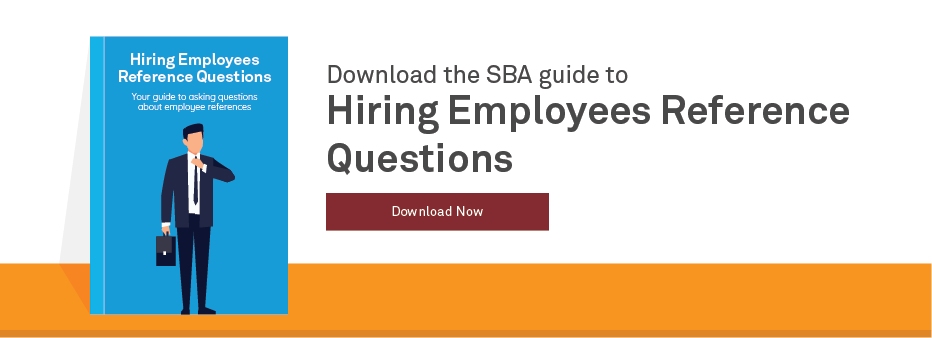During the hiring process there are several stages at which you’ll need to screen candidates. This includes the pre-interview stage, during which you’ll screen applicant resumes, and the post-interview stage when your screening may include calling references, ordering background tests and possible even drug testing. All this screening takes time, but it’s worth it to save you from making a poor hiring decision—one that could especially devastate small businesses. To help you make sense of each screening step and to give you actionable tips to develop your own processes, we’ll cover each type of screening in this guide.
Early Resume Screening Tips
Job ads are nearly always part of the hiring process, but they can generate an overwhelming number of resumes to sift through. Depending on the position you may be inundated with resumes—even if you took the time to write an accurate job description before strategically promoting a very specific job ad targeted to just the type of candidate you want to attract. The truth is, you’ll likely end up with more applications than you have time to interview at some point in your experience as a small business owner.
So, when you’re up to your ears in resumes, how do you even begin? Small business expert, Gene Marks, offers to ways to immediately disqualify candidates without having to spend much time reading their applications:
Eliminate resumes from anyone who clearly didn’t give your job ad a thorough read. “If someone can’t follow the simple instructions I laid out in my Craigslist ad, how can I expect them to follow my instructions in the workplace? If my ad specifically asks for someone in my local area (Philly), I immediately remove anyone living in California (or India or Russia). I also delete candidates who are seeking a full-time position when my ad states that the opportunity is part-time.”
De-prioritize all Word documents. “We live in an age of malware, viruses and data breaches. A macro fired off from a Microsoft Word doc is one of the easiest ways to do spread tech diseases. If you send me a Word doc, I’m probably going to place it the back of the queue. I prefer PDFs—and I say so in my ad.”
Following both pieces of Marks’ advice – removing resumes in Word docs and eliminating anyone who shows inattention to detail – will get you well on your way toward narrowing your candidate pool, but you’ll likely need to spend a bit more time screening resumes before you can start interviewing.
Resume Red Flags
Before moving on toward selecting your top candidates, you can further shrink the applicant pool by identifying red flags on their resumes, including:
- Spelling or grammatical mistakes
- Sloppy or confusing formatting
- Signs of lessening responsibility
- Multiple periods of unemployment
- Several career shifts
- Evidence of compulsive job hopping
If you notice too many red flags on one resume, you can safely remove it from your consideration.
A Foolproof System for Screening and Ranking Resumes
Once you’ve removed any resumes that aren’t worth a closer look, it’s time to evaluate the ones you have left. Your process should allow you to efficiently compare them, single out the best ones, and prepare for the interviews. To help you do just that, we’ve outlined a system below.
Step 1: Create a priority list — understand what’s most important and write it down
If you jump right into your resume pile without a plan, you risk getting distracted and wasting time. Don’t go in blind. Before you begin, reread the job description. Once it’s fresh in your mind, consider your ideal candidate. Then get out a pen and paper to flesh out this candidate with these three columns:
- Key traits and characteristics (including soft skills like adaptability and teamwork)
- Essential technical training and other hard skills
- Industry experience, including working for related companies
After filling out these three qualities, assign a colored highlighter to each column. (For the sake of our story here, let’s use an orange highlighter for key traits, pink for essential training, and blue for industry experience.) You’ll use these highlighters while screening resumes, and these priorities will serve as your guideposts during the process.
Step 2: Quickly screen resumes — skim and highlight
Prepare by getting out the stack of resumes, your three highlighters, and a pen. Then create space on your desk to make three piles: “green,” “yellow,” and “red”:
- Green = standouts you definitely want to interview
- Yellow = candidates you may want to interview
- Red = resumes in which you’re least interested
As you start skimming resumes, keep your priorities in mind. Look for and highlight relevant things on each resume based on your color code (using our example above, that would be orange for key traits, pink for essential training, blue for industry experience). Your main objective is weeding out unqualified candidates and discovering stellar ones, so don’t take copious notes at this point. Sort resumes into your three piles as you go.
When you get resumes that aren’t even close, write down why (for example, “Doesn’t have the required years of experience”) and put them in the red pile*. If you realize you’re getting mostly red pile resumes, then it may be time to take another look at your job description and consider why it’s attracting so many unqualified candidates.
*Pro Tip: Don’t forget about your red pile. Find time to email each of these candidates a lightly templated note to inform them that they are no longer being considered for the role and why. This is important for your brand as an employer. As more and more job candidates write about their experiences on employer review sites, if they feel their application went into a black hole because they never heard back from you, it can earn you a harsh review. And Marks suggests keeping all resumes, even those in your red pile. “Even if [candidates are] not chosen now, they may have some use to me (or my clients) in the future. Who knows?”
While skimming your stack of resumes, keep an eye out for the following:
- Keywords related to your priorities. When you notice words that relate to your priority columns from Step 1 (that is, character traits, relevant training or technology, industry experience, specific employers), highlight them using the color code you planned. Take it a step further by using your pen to assign a star-system to indicate how well each candidate is qualified based on the context around the highlighted priorities. You’ll thank yourself later when you’ll be ranking resumes.
- Gaps in employment. Circle any employment gaps on resumes that otherwise belong in the green or yellow piles. Doing so will remind you to ask about this should you decide to interview that candidate.
Step 3: Rank the resumes — and prepare for interviews
Start with your green pile. You should have at least three resumes here, but no more than 10. If you were picky, you may need to add a couple resumes from your yellow pile, but good news! Your highlighted resumes should make selecting the best ones quick work.
Get ready to rank. Once you have enough resumes in your green pile, review them based on your criteria from Step 1. Before this final screen, read the job description again to ensure it’s top of mind. Then create a document — digital or print — to record your thoughts about each resume and prepare questions as you read them.
Prepare questions while you read. Don’t just look for buzzwords; use this time to consider the substance and quality of each candidate’s experience. For anything you highlighted in Step 1, delve deeper by planning a question to help you understand how a candidate applied their knowledge and skill on the job.
Look for any gaps. Once you’ve recorded questions based on what you see on the resume, consider what it may be missing. Are there certain skills or knowledge you’re hoping for that aren’t there? Ask about them to find out how the candidate plans on growing into the role. Other factors you can’t often discern from resumes are someone’s working style and office culture preferences, so plan interview questions to discuss these as well.
After preparing questions for each of your top candidates, rank the resumes and begin the interview process in that order.
Check References Before You Extend a Job Offer
Once you’ve finished interviewing your top candidates you should have a good idea about which person you’d like to hire. Prior to offering them the job though, you have one last opportunity to gain even more insight about whether this candidate will make a good addition to your team: their personal and professional references. Tell your candidate that you’ll be calling their references — even suggest they give these people a heads up, so they’ll be prepared to receive your call.
Ask the right reference check questions to make an educated decision. Follow this formula: get context, verify facts, give context, uncover red flags, and assess fit. Keep in mind, though, that your candidate’s references may have busy schedules. After you give them some context about your open position, plan to ask them the most important questions first. Use the below comprehensive list to select questions based on your priorities for the role and any concerns you may have about your candidate.
Gain Context and Verify Facts: Questions to Ask References First
Let’s say you’re about to hire Jane, but you’re wise and decide to call her references before extending an offer. After exchanging greetings with the reference and explaining why you’re calling, start with the following introductory questions to gain valuable context:
- How do you know Jane?
- In what capacity did you work with Jane?
- How long did you work with Jane?
These questions should help you determine how heavily to weigh each reference’s answers in your hiring decision. Once you understand the person’s relationship to Jane, you can decide whether it makes sense to ask them to verify these important facts: dates of employment, job title(s), responsibilities, why Jane left (if applicable), and if Jane is eligible for rehire at that employer.
The aim here is to ensure that Jane has been truthful, but don’t just stop there. Head to the next section to uncover whether her references’ perceptions of Jane line up with her own ideas about her performance, strengths, and weaknesses.
Pro Tip: Depending on the circumstances, and the reference’s relationship to your candidate, they may not have all the answers you need. If none of your candidate’s references can verify facts such as tenure and job responsibilities, you can usually call past employers’ main lines or HR departments to do so.
Assess Aptitude, Skills, and Fit: Five Types of Reference Check Questions
You can make a more informed hiring decision by asking the five types of reference check questions below. Insights from people who have worked with Jane can help you decide whether to hire her, better understand how to manage her, and plan for her first months on the job. Listen not only for red flags, but also for valuable nuggets on how to play to her strengths and plan for her weaknesses.
1. Offer Context
Before you jump in, give the person some context about what you’re looking for by asking them the following question. This will set them up to answer the rest of your questions with a full understanding of what you need:
- I’m considering Jane for [job title]. She’d be responsible for [responsibilities]. Do you think she could perform well in this role, and why or why not?
2. Gain an Understanding of Strengths and Weaknesses
Next, ask about her strengths and weaknesses. You probably asked Jane these same questions, but it can hard to give an honest answer about yourself. You’ll benefit by getting an outside perspective on Jane, especially from people who have worked with her.
When listening to the answers, keep in mind that most people have a few weaknesses. This doesn’t mean you shouldn’t hire them. Knowing Jane’s weaknesses ahead of time can give you ideas about how to best help her develop. And asking about Jane’s strengths can help you understand the immediate impact she could make, so you can plan what you’d like her to tackle during her first months on the job:
- What are Jane’s weaknesses, and do you feel she could overcome them with adequate training?
- What are Jane’s strengths and how did she use them?
3. Uncover Red Flags and Discover Whether the Candidate Will Be a Good Fit
This next set of questions can help you discover whether there are reasons not to hire Jane. And even if there aren’t any red flags, the references’ answers can help you prepare for how best to manage Jane and decide whether she’ll work well with your existing team and thrive in your office culture:
- How did Jane handle challenges, whether pressure to meet a deadline, stress with a tough goal, or conflict with colleagues?
- Could you describe Jane’s working style? What’s it like to work with her?
- How well did Jane work with others?
- Did Jane have any issues with colleagues and/or management?
- Do you have any advice for how to manage Jane?
- Did Jane prefer to work on her own or as part of a team?
- What role did Jane take on when part of a team? (for example, leader, encourager, organizer, planner?)
4. Determine Potential for Future Growth (questions 11-12)
If you are looking to hire someone who can not only help your company grow but also grow with your company and take on more responsibility, then consider asking the following:
- Would Jane make a good manager? Why or why not?
- Was Jane promoted or given additional responsibilities at any point? Why or why not?
5. Ask Closing Questions (questions 13-15)
Give the reference one more chance to add anything that you should know but didn’t ask:
- If you could work with Jane again, would you want to?
- Is there anything else I should know about Jane that would help me make this hiring decision?
- Can you think of anyone else I should speak to?
You may think that doing a reference check isn’t a great use of your time, especially if you’re busy. After all, who is going to give you the number for someone who might give them a bad reference? But the right references can provide a wealth of knowledge about everything from your next hire’s working style, to their potential for growth, so make the time to call them.
The knowledge you gain could not only save you from making a bad hire, but also help you better plan to welcome a talented new team member. Employees are an investment, so plan to make the most of them — from their very first day!
When to Request Background Checks and Drug Tests
Your candidate presented a promising resume and interviewed well, and her reference checks went great. It’s time to extend a job offer. Not only will you need to write the offer letter, but now may also be the time for a background check and drug test—if necessary to the role.
Why not conduct these checks before extending an offer? In some cities and states, employers can get into legal trouble if they conduct background checks and drug tests prior to offering the candidate a job. The best way to protect your small business is to take these steps as part of your job offer process, so make the offer letter contingent upon a clean background check—and drug test, if necessary.
Pre-Employment Background Checks
You may want to request a background check to ensure that you, your employees and your business are safe. These checks typically include criminal records, social security confirmation, address history, sex offender registry and the U.S. terror watch list. Depending on the role, especially if it’s one that involves either company finances or operating company machinery, employers may also request:
- Driving records
- Credit reports
- State licensing
- Professional licensing
In order to stay on the right side of the law, make sure you follow a consistent process when it comes to background checks:
- Do not request background on a candidate-by-candidate basis. This can appear to be discriminatory. If you request a background check for one candidate, make sure you do this for all candidates interviewing for related roles.
- Check your local laws and, if possible, get legal advice from a local attorney who specializes in employment law.
- Tell candidates in writing what their background check will include.
For more information on the do’s and don’ts of background testing, visit the Equal Employment Opportunity Commission’s (EEOC) webpage on this topic.

Pre-Employment Drug Tests
If the role you’re hiring for involves transportation of company goods and/or safe operation of warehouse machinery, it may make sense to include drug tests as part of your pre-hire screening. Employment laws get complicated when it comes to drug testing, though, so do all you can to ensure that your processes are legal.
While there are some federal bodies with laws related to drug testing, such as the Department of Transportation, there are also state laws about employment-related drug testing that vary. So, as with background tests, research state and local laws governing your business before you make any decisions about how this will fit into your hiring process. Good rules of thumb to follow while establishing your written pre-hire drug test policies:
- Establish which types of roles will require drug tests
- Determine when and how drug tests will take place
- Decide which drugs you’ll test for
- Develop a course of action that will be followed for every candidate who test positive
Each time you hire a new employee, you gain an opportunity and a risk. They could end up being your best team member, making a huge difference at your company…or they could be a bad hire that costs you time, money, and morale. Before you take the leap of extending an offer and hiring someone, protect your business by making time to effectively follow all necessary screening processes.
Have you used any of these screening processes in the past? Which ones are you looking forward to implementing? Leave us a comment below.





